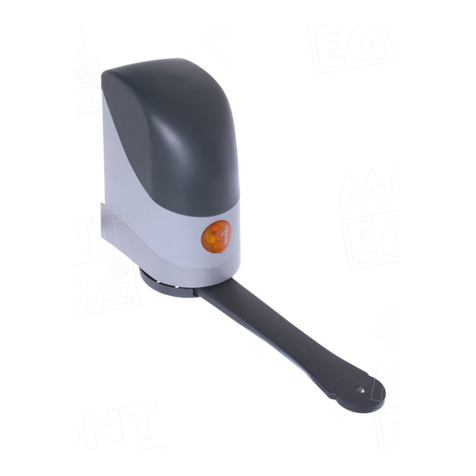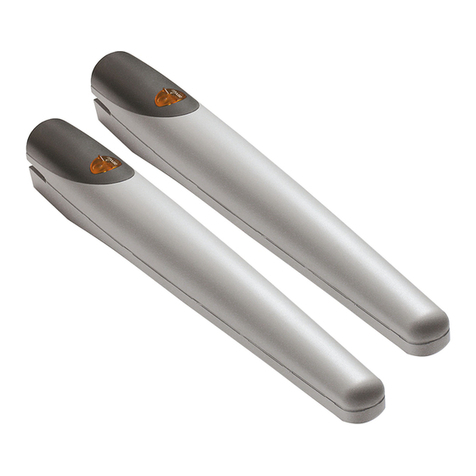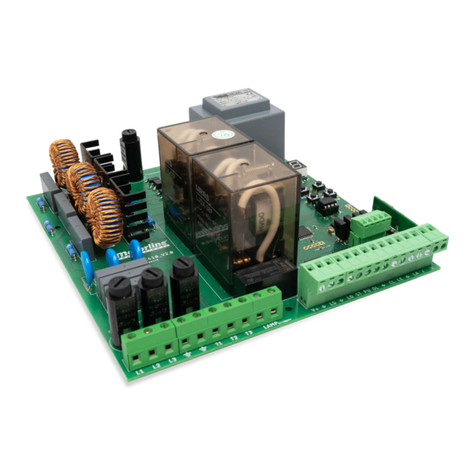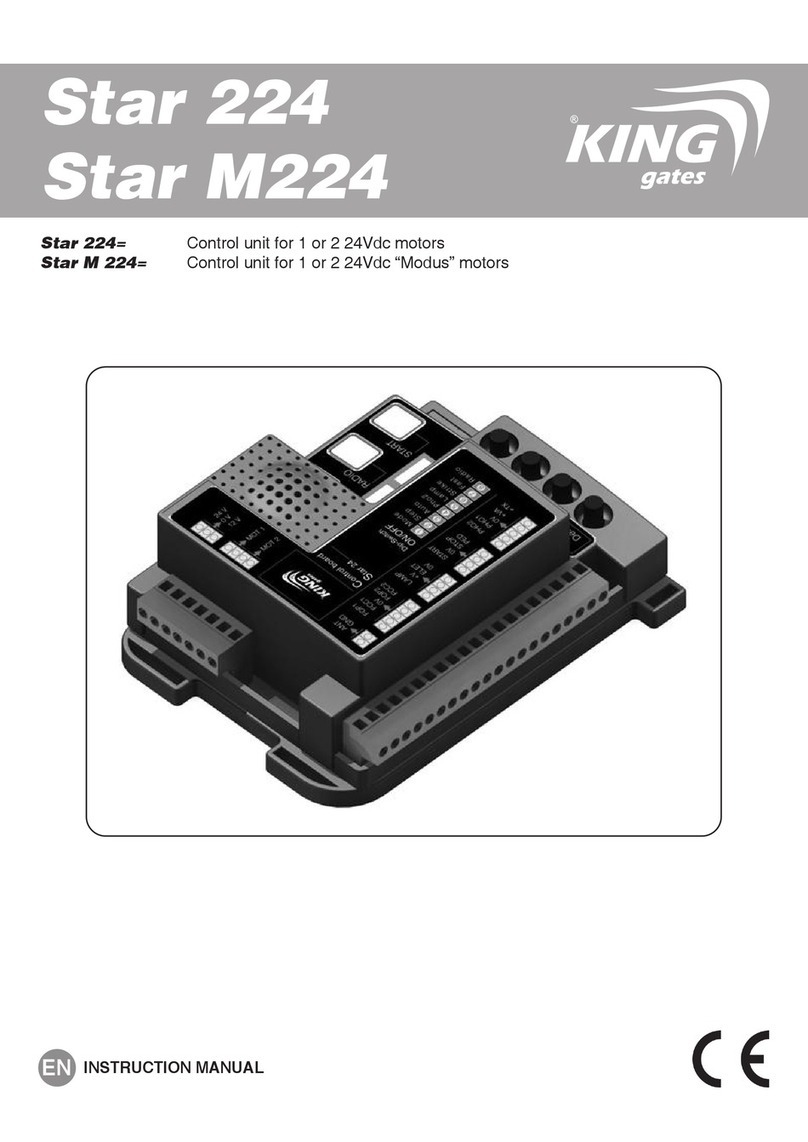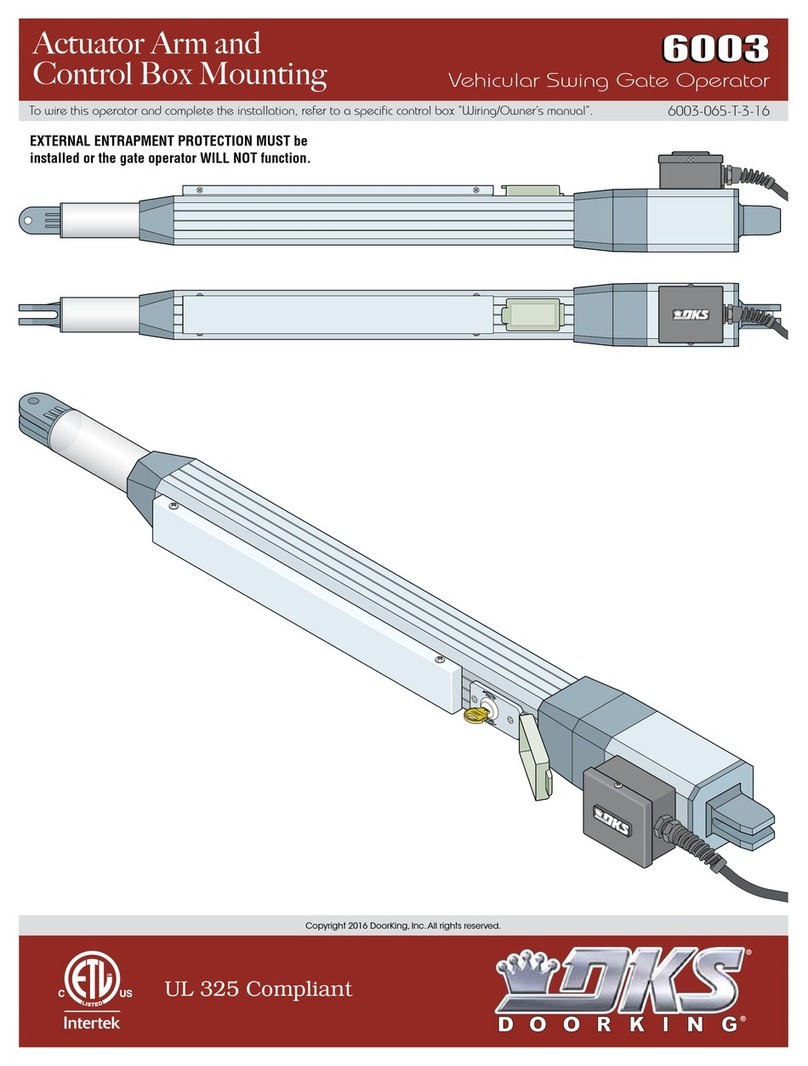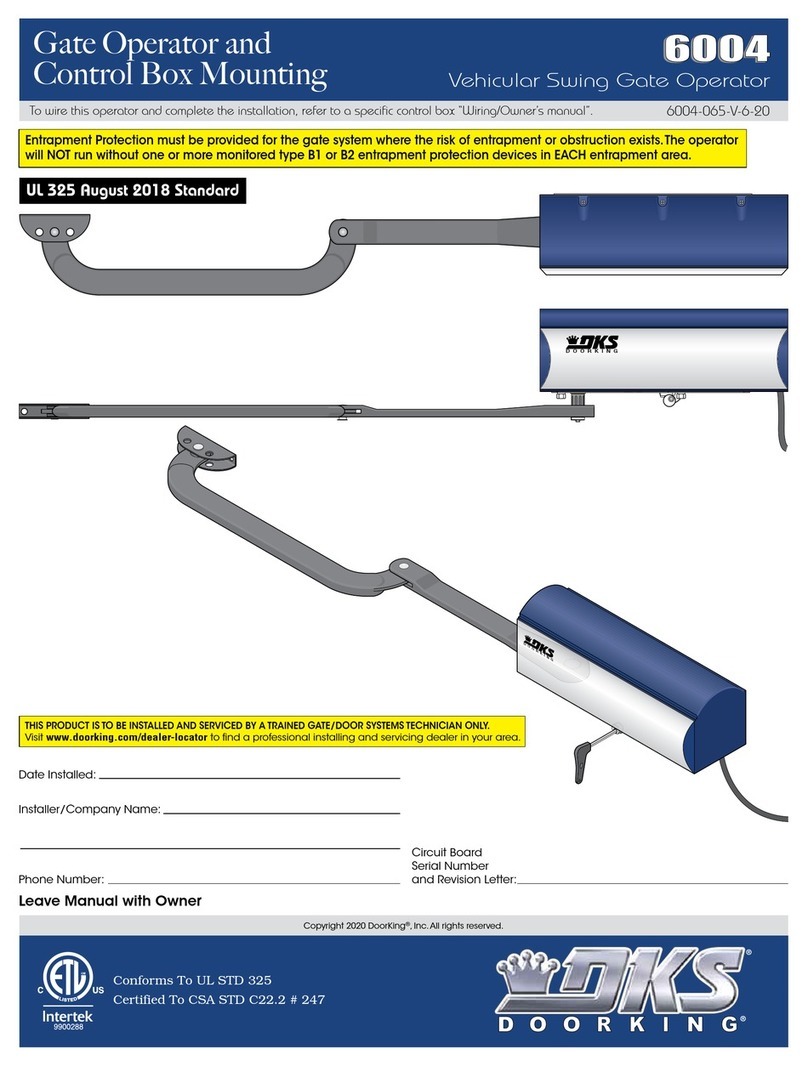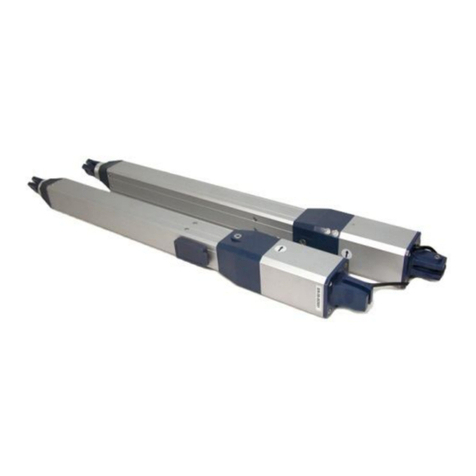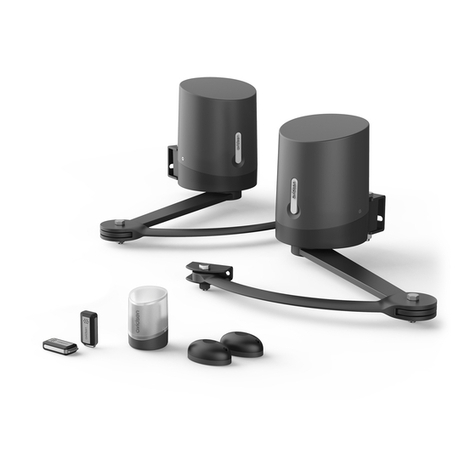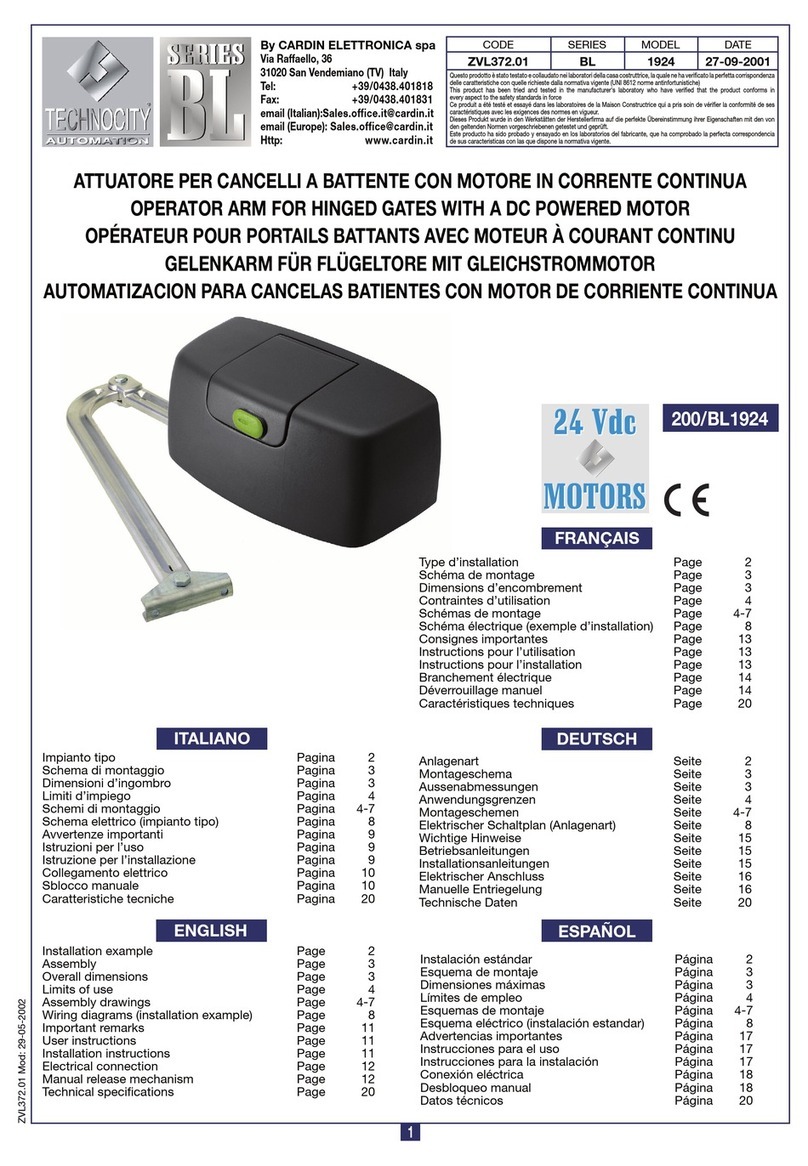Mhouse SL1 User manual

Installation instructions and warnings
English
IST SL1-GB 4865 Rev. 02
MhouseKit SL1
For the automation of sliding gates

This manual may be reproduced provided no part of it is omitted or
modified. No part of this manual may be translated into other languages
without the prior authorization and subsequent examination by
MHOUSE.
MHOUSE disclaims all responsibility for damage resulting from improper
use of its products. You are therefore invited to read this manual carefully.
MHOUSE, in order to improve its products, reserves the right to modify
them at any time without prior notice. In any case, the manufacturer
guarantees their functionality and fitness for the intended purposes.
For any information please contact:
MHOUSE S.r.l.
via Pezza Alta, 13, Z.I. 31046 Oderzo
Tel: 0422 202109
Fax: 0422 852582
email: [email protected]
http: www.mhouse.biz
2Instructions SL1
Information
1 Warnings 3
2 Product Description 4
2.1 Applications 4
2.2 Description of the automation 4
2.3 Description of devices 5
2.3.1 SL1K Electromechanical Gearmotor 5
2.3.2 Release keys 6
2.3.3 PH1 photocells 6
2.3.4 KS1 Key-Operated Selector Switch 6
2.3.5 FL1 flashing light with incorporated aerial 6
2.3.6 TX4 Radio Transmitters 6
3 Installation 7
3.1 Preliminary checks 7
3.1.1 Operating Limits 8
3.1.2 Tools and Materials 8
3.1.3 List of cables 9
3.2 Preparing the Electrical System 9
3.2.1 Connection to the Electrical Mains 9
3.3 Installation of the Various Devices 10
3.3.1 Mounting on gates without rack 10
3.3.2 Mounting on gates with a rack 11
3.3.3 Photocells 13
3.3.4 KS1 Key-Operated Selector Switch 13
3.3.5 FL1 Flashing Light 14
3.3.6 Electrical connections to the SL1K control unit 15
3.4 Power Supply Connection 17
3.5 Initial checks 17
3.5.1 Recognition of Connected Devices 17
3.5.2 Checking gate movements 18
3.5.3 Checking the Radio Transmitters 18
3.6 Regulations 18
3.6.1 Selecting gate speed 18
3.6.2 Selecting the Type of Operating Cycle 19
3.7 Testing and Commissioning 19
3.7.1 Testing 19
3.7.2 Commissioning 19
4 Maintenance 20
4.1 Dismantling and Disposal 20
5 Additional information 21
5.1 Advanced Adjustments 21
5.1.1 Adjusting the Parameters with the Radio Transmitter 21
5.1.2 Checking the Adjustments with the Radio Transmitter 22
5.2 Optional Accessories 22
5.3 Adding or Removing Devices 22
5.3.1 ECSBus 22
5.3.2 STOP Input 22
5.3.3 Recognition of Other Devices 23
5.3.4 Addition of Optional Photocells 23
5.4 Memorization of Radio Transmitters 24
5.4.1 Memorization Mode 1 24
5.4.2 Memorization Mode 2 24
5.4.3 "Remote" Memorization 24
5.4.4 Deleting a Radio Transmitter 25
5.4.5 Deleting all the Radio Transmitters 25
5.5 Troubleshooting 25
5.6 Diagnostics and Signals 26
5.6.1 Photocells 26
5.6.2 Flashing light 26
5.6.3 Control Unit 27
6 Technical Charateristics 28
7 Annexes 30
7.1 Annexe 1: CE Declaration of Conformity of SL1 Components 31
7.2 Annexe 2: CE Declaration of Conformity of Power Operated Gate 33
7.3 Annexe 3: Operating Guide 35
7.3.1 Safety regulations 35
7.3.2 Gate Control 35
7.3.3 Maintenance Operations to Be Performed by the User 36
7.3.4 Replacing the Remote Control Battery 36
Contents
WU2 is produced by NICE S.p.a. (TV) I, MHOUSE S.r.l. is an affiliate of
the Nice S.p.a group.

Instructions SL1 3
1 Warnings
• If this is the first time that you install a SL1 gate automation system we
recommend that you dedicate some of your time to reading this manual.
You should read it before you start installing the system, so you don't
have to rush to finish the work.
Keep all the components of the SL1 system handy so that you can read,
check and verify all the information contained in this manual. However,
do not carry out the adjustment and memorization stages otherwise,
during the actual installation of the products, you will have to deal with
settings that differ from the original factory ones.
• When reading this manual, pay special attention to the sections
marked by the following symbol:
these sections are particularly important for safety.
• Store this manual safely for future use.
• This manual, as well as the design and manufacture of the devices that
make up SL1, comply fully with the standards and regulations in force.
• Considering the hazards that may exist during the installation and
operation of SL1, it is necessary that also the installation be carried out
in strict compliance with current legislation, standards and regulations,
particularly:
• This manual contains important information regarding personal
safety; before you start installing the components, it is important
that you read and understand all the information contained
herein. Do not proceed with the installation if you have doubts of
any sort; if necessary, refer to the MHOUSE customer service
department for clarifications.
• Before you start with the installation, make sure that each
single SL1 device is suitable for the intended automation
purposes; pay special attention to the data provided in chapter 6
"Technical Characteristics". If even a single device is not suitable
for the intended application, do not proceed with the installation.
• Before you start with the installation, check whether additional
devices or materials are needed to complete the automation with
SL1 based on the specific application requirements.
• The SL1 automation system must not be used until the
automation has been commissioned as described in paragraph
3.7.2 "Commissioning".
• The SL1 automation system cannot be considered as a suitable
intrusion protection system. If you require efficient protection you
need to integrate SL1 with other devices.
• The packing materials for SL1 must be disposed of in
compliance with local regulations.
• Do not make modifications to any components unless provided
for in this manual. This type of operations will only cause
malfunctions. MHOUSE disclaims any liability for damage
resulting from modified products.
• Components must never be immersed in water or other liquids.
Also during installation, do not allow liquids to enter the
gearmotor or other open devices
• In the event that liquid substances have penetrated inside the
automation devices, immediately disconnect the power supply
and contact the MHOUSE customer service department. The use
of SL1 in these conditions can be dangerous.
• Keep all components of SL1 away from heat sources and open
flames; these could damage the components and cause
malfunctions, fire or dangerous situations.
• During long periods of inactivity, the optional battery (PR1)
should be removed and stored in a dry location to prevent
leakage of noxious substances.
• Connect the gearmotor only to a power supply line equipped
with safety grounding system.
• All operations requiring the opening of the protection shell of
any SL1 device must be performed with the gearmotor
disconnected from the power supply (and from the PR1 buffer
battery, if featured); if the disconnection device is not identifiable,
post the following sign on it: "WARNING: MAINTENANCE WORK
IN PROGRESS".
• In the event that any automatic switches or fuses are tripped,
you must identify the failure and eliminate it before you reset
them.
• If a failure occurs that cannot be solved using the information
provided in this manual, refer to the MHOUSE customer service
department.

4Instructions SL1
The following example of a typical SL1 application will serve to clarify a few terms and aspects of a gate automation system:
A) KS1 key-operated selector switch.
B) Pair of PH1 photocells
C) FL1 flashing light with incorporated aerial.
D) Pair of PT50 posts for photocells (not included).
E) Mechanical stop in closing cycle
F) Ground guide (track)
G) Opening limit switch bracket.
H) CR100 rack (not included).
I) SL1K gearmotor complete with control unit.
J) Closing limit switch bracket.
2.2 Description of the automation
A
D E G H ID
B B C
Figure 1
2 Product Description
2.1 Applications
SL1 is a set of components designed for the automation of sliding gates
in residential applications.
Any applications other than those described above or under
different conditions from those specified in this manual are
forbidden.
SL1 operates with electric power. In the event of a power failure, the
gearmotor can be released using suitable keys in order to move the gate
manually. Alternatively, the PR1 buffer battery (optional accessory) can
be used.
FJ

Instructions SL1 5
SL1 consists of the devices shown in figure 2;
make immediately sure that they correspond to
the contents of the package and verify the
integrity of the devices.
Note: to adapt SL1 to local regulations, the
contents of the package may vary; an exact list
of the contents is shown on the outside of the
package under the "Mhousekit SL1 contains"
heading.
2.3 Description of devices
A) 1 motoriduttore elettromeccanico SL1K
con centrale di comando incorporata e
piastra di fondazione.
B) 3 release keys.
C) 1 pair of PH1 photocells (consisting of a TX
and an RX).
D) 2 TX4 radio transmitters.
E) FL1 flashing light with incorporated aerial.
F) 1 KS1 key-operated selector switch and
two keys.
G) 2 limit switch brackets
H) Miscellaneous small parts: screws, screw
anchors, etc. (see tables 1,2,3,4).
SL1 is an electromechanical gearmotor consisting of a helical geared
reduction gear and a 24V direct current motor. It features a key-operated
mechanical release mechanism that allows you to move the gate
manually in the event of a power failure.
The gearmotor is fixed to the ground at the side of the gate with the
relative foundation plate and operates the gate with a rack and pinion
system.
The control unit actuates the gearmotors and provides for the control
and supply of the different components; it features an electronic board
with incorporated radio receiver.
SL1K includes a housing [C] for the PR1 buffer battery (optional), which
is necessary for operation in case of power failure.
The control unit can actuate the gearmotor with two speeds: "slow" and
"fast".
The three P1, P2 and P3 buttons [B] and the corresponding LED's are
used to program the control unit.
The yellow button allows the gate to be controlled locally during testing.
To facilitate the electrical connections there are separate terminals for
each device [A], which are removable and colour-coded based on the
function performed. Next to each input terminal there is a LED that
signals its status.
The connection to the power supply is very easy: just insert the plug in a
power outlet.
Table 1: List of small parts for a SL1K Q.ty
Bent pins 2 pcs
M8 nuts 4 pcs
M8 self-tapping nuts 2 pcs
Ø10mm flat washers 2 pcs
6x14mm dowels 4 pcs
8x20mm dowels 4 pcs
2.3.1 SL1K Electromechanical Gearmotor
Figure 3
Figure 2
A
BCD
E
G
F
H
A
B
C

6Instructions SL1
2.3.3 PH1 photocells
The pair of PH1 wall-mounted photocells, once they are connected to
the control unit, enable the detection of obstacles found on the optical
axis between the transmitter (TX) and the receiver (RX).
2.3.4 KS1 Key-Operated Selector Switch
The KS1 key-operated two-position selector switch enables gate
control without using the radio transmitter. It is equipped with internal
light for locating in the dark.
There are two commands, which depend on the direction of rotation of
the key: "OPEN" and "STOP"; then the key, which is spring loaded,
returns to the centre position.
Figure 6
2.3.5 FL1 flashing light with incorporated aerial
The flashing light is controlled by the control unit and signals danger
when the gate is moving. Inside the flashing light there is also the aerial
for the radio receiver.
Figure 7
2.3.6 TX4 Radio Transmitters
The radio transmitters are used for the remote control of the gate
opening and closing manoeuvres. They feature four buttons that can all
be used for the 4 types of command to a single automation unit, or to
control up to 4 different automation units.
The transmission of the command is confirmed by the LED [A]; an eyelet
[B] allows them to be hung on a keyring. Figure 8
B
A
Figure 5
The three keys enable the gearmotor to be released in the event of a
power failure.
2.3.2 Release keys
Figure 4
Table 3: List of small parts for PH1 Q.ty
HI LO 4X9.5 screw 4 pcs.
3.5X25 self-tapping screw 4 pcs.
s 5 c nylon screw anchor 4 pcs.
Table 4: List of small parts for KS1 Q.ty
HI LO 4X9.5 screw 4 pcs.
3.5X25 self-tapping screw 4 pcs.
s 5 c nylon screw anchor 4 pcs.
Table 5: List of small parts for FL1 Q.ty
4.2X32 self-tapping screw 4 pcs.
s 6 c nylon screw anchor 4 pcs.

SL1 must not be used to power a gate that is not efficient and
safe. It cannot solve defects resulting from incorrect installation
or poor maintenance of the gate.
Before proceeding with the installation you must:
• Make sure that the weight and dimensions of the gate fall within
the specified operating limits. If they do not, SL1 cannot be used.
• Make sure that the structure of the gate is suitable for
automation and in compliance with regulations in force.
• Make sure that there are no points of greater friction in the
opening or closing travel of the gate.
• Make sure there is no danger of the gate derailing.
• Make sure that the mechanical stops are sturdy enough and
that there is no risk of the gate derailing out of the ground guide
even when it hits the mechanical stop violently.
• Make sure that the gate is well balanced: it must not move by
itself when it is placed in any position.
• Make sure that the area where the gearmotor is fixed is not
subject to flooding. If necessary, mount the gearmotor raised
from the ground.
• Make sure that the installation area is compatible with the size
of the gearmotor and that it is safe and easy to release it.
• Make sure that the mounting positions of the various devices
are protected from impacts and that the mounting surfaces are
sufficiently sturdy.
• Make sure that the mounting surfaces of the photocells are flat
and that they enable the proper alignment between TX and RX.
• Make sure there is a suitable fixing surface at the points where
the rack is fixed to the gate. For the CR100 rack, see figure 10.
• Both with the gearmotor mounted to the left "LT" and to the
right "RT", the distances indicated in figure 11 (gate without rack)
or figure 12 (gate with rack) must be respected.
Instructions SL1 7
The installation must be carried out by qualified and skilled
personnel in compliance with the directions provided in chapter
1 "Warnings".
3 Installation
3.1 Preliminary checks
Figure 9
300
295
163
84
Figure 11
50
0 ÷ 50
Figure 10
60
SX
DX
50 ÷ 100
50
0 ÷ 50
50 ÷ 100
10
10
Figure 12
SX
DX

8Instructions SL1
3.1.1 Operating Limits
3.1.2 Tools and Materials
Make sure you have all the tools and materials needed to install
the system; make sure that they are in good condition and
serviceable according to current safety standards. See examples
in figure 16.
Figure 16
• To mount the limit switch brackets, the rack (and therefore the
gate) must project from the axis of the pinion by the distances
indicated in figure 13 (LT opening) and figure 14 (RT opening).
If the rack is already mounted on the gate, make sure its position
is compatible with the size limits indicated in figure 15 and check
that the pitch of the rack is module 4 (approx. 12mm).
Figure 15
Figure 13
200
170
170
200
Figure 14
77
Chapter 6 "Technical Characteristics" provides the fundamental data
needed to determine whether all the SL1 components are suitable for
the intended application.
In general, SL1 is suitable for the automation of gates up to 5 m long,
weighing up to 350 kg for residential applications.
The shape of the gate and the climatic conditions (e.g. presence of
strong wind) may reduce this maximum limit. In this case it is necessary
to measure the torque needed to move the leaves under the worst
conditions, and to compare it to the data provided in the technical
characteristics chart for the gearmotor.

Instructions SL1 9
3.1.3 List of cables
The cables required for the installation of SL1 may vary depending on the type and quantity of devices to be installed; figure 17 shows the cables
needed for a typical installation; no cable is supplied with SL1.
Figure 17
A
CF
3.2 Preparing the Electrical System
WARNING: the cables used must be suitable for the type of installation; for example, an H03VV-F type cable is recommended for indoor
applications, while H07RN-F is suitable for outdoor applications.
B C DC E C
3.2.1 Connection to the Electrical Mains
Table 5: List of cables
Connection Cable type Maximum length allowed
[A] STOP input 2x0,5mm2 cable 20m (note 2)
[B] OPEN input 2x0,5mm2 cable 20m (note 2)
[C] ECSBus input/output 2x0,5mm2 cable 20m (note 2)
[D] FLASH light output 2x0,5mm2 cable 20m
[E] Radio aerial RG58 type shielded cable 20m(recommended less than 5m)
[F] Power supply line 3x1.5mm2 cable 30m (note 1)
Note 1 A power supply cable longer than 30 m may be used provided it has a larger gauge, e.g. 3x2.5mm2, and that a safety grounding system
is provided near the automation unit.
Note 2 For the ESCbus, STOP and OPEN cables, there are no special contraindications to the use of a single cable that groups together multiple
connections; for example, the STOP and OPEN inputs can be connected to the KS1 selector switch using a single 4x0,5mm2cable.
With the exception of the power line, the rest of the system uses extra-
low voltage (approx. 24V); the wiring can therefore be done by personnel
that is not properly qualified, provided that all the instructions in this
manual are carefully observed.
After selecting the position of the various devices (refer to figure 1) you
can start preparing the conduits for the electrical cables connecting the
devices to the control unit.
The conduits are designed to protect the electrical cables and prevent
accidental breakage, which may be caused by the passage of vehicles,
for instance.
Although the connection of SL1 to the electrical mains is beyond the
scope of this manual, we wish to remind you that:
• The power supply line must be laid and connected by a qualified
professional electrician.
• Alternatively, have a suitably protected 16A "shuko" outlet
installed, where you can plug in SL1.
• The power supply line must be protected from short circuits
and ground leakage; a device must be provided to enable the
disconnection of the power supply during the installation and
maintenance of SL1 (the plug with outlet are suitable for this
purpose).

1Dig the foundations according to the "Preliminary checks" paragraph
and in particular the distances indicated in figure 11 on page 10.
2Lay the conduits for the power cables leaving them 30-50 cm longer.
3Fit the two bent pins [B] into the foundation plate and fix them above
and below with two M8 nuts [A]; make sure the projecting part does not
exceed the maximum height indicated in the figure.
4Position the foundation plate making sure that the grooved side
(indicating the position of the pinion) faces the gate observing the
distances shown in figure 11.
5Fit the conduits through the hole in the foundation plate.
6Pour the concrete.
7Sink the plate into the concrete and make sure it is perfectly level.
8When the concrete is dry enough (after a few days), unscrew the two
nuts over the plate as they which will no longer be used.
9Cut the cable conduits approximately 3-4cm above the plate.
10 Remove the nut cover on the gearmotor.
3.3 Installation of the Various Devices
3.3.1 Mounting on gates without rack
Figure 18
10 Instructions SL1
The SL1K gearmotor can be mounted in the two different situations:
A) Mounting on a gate without rack (paragraph 3.3.1 ); in this case the
gearmotor must be installed first, followed by the CR100 rack.
B) Mounting on a gate with rack (paragraph 3.3.2 ); in this case the
gearmotor must be adapted to the existing rack.
Figure 19
36
B
A
Figure 20
Figure 21

11 Place the gearmotor on the foundation plate, make sure it is perfectly
parallel with the gate and fix it with two self-locking nuts [C] and washers
[D]. Thoroughly tighten the two nuts.
12 Release the gearmotor using the appropriate release keys (see the
"Gearmotor release" paragraph on page 36).
13 Fully open the gate and place the first piece of the rack on the pinion
so that it projects from the axis of the pinion by the distance indicated in
figure 13 or figure 14, that is, the space required for the limit switch
brackets.
14 To keep the rack level with the pinion, mark the hole for fixing when
the slot matches the axis of the pinion. Repeat this operation for each
fixing point.
15 Leave a play of 1 mm between the rack and the pinion so that the
gate does not weigh on the gearmotor.
16 Mount the other pieces of the rack and align them one after the other
with a play of 1 mm on the pinion.
17 After fixing the last piece, cut away the projecting part of the rack with
a hacksaw if necessary.
18 Open and close the gate several times by hand and make sure that
the rack is aligned with the pinion with a maximum tolerance of 5mm.
19 Fix the two limit switch brackets with the relative dowels [E] to the
outer sides of the rack.
Consider that the gate will slide for about another 2-3 cm after the limit
switch cuts in. The brackets should be positioned at a sufficient distance
from the mechanical stops in order to prevent the gate from jamming.
20 To electrically connect the various devices, see paragraph 3.3.6
"Electrical Connections" on page 15.
Instructions SL1 11
Figure 22
D
C
Figure 23
Figure 24
Figure 25
E
3.3.2 Mounting on gates with a rack
1Dig the foundations according to the "Preliminary checks" paragraph
and in particular the distances indicated in figure 11 on page 7. Make
sure the foundation plate is 77 mm from the rack, see figure 15.
2Lay the conduits for the power cables leaving them 30-50 cm longer.
Figure 26

12 Instructions SL1
3Fit the two bent pins [B] into the foundation plate and fix them above
and below with two M8 nuts [A]; make sure the projecting part does not
exceed the maximum height indicated in figure 27.
4Position the foundation plate making sure that the grooved side
(indicating the position of the pinion) faces the gate observing the
distances shown in figure 11.
5Fit the conduits through the hole in the foundation plate.
6Pour the concrete.
7Make sure the plate is sunk into the concrete and that it is perfectly
level.
8When the concrete is dry enough (after a few days), unscrew the two
nuts over the plate which will no longer be used.
9Cut the cable conduits approximately 3-4cm above the plate.
10 Remove the nut cover on the gearmotor.
11 Fit the gearmotor to the foundation plate underneath the rack. This
operation can be simplified by tilting the gearmotor so that the pinion can
easily pass under the rack. Tighten the two self-locking nuts [C] a little
after fitting the washers [D].
12 If necessary, adjust the height of the gearmotor (Max. 10mm) with the
4 dowels so that there is at least 1mm of play between the rack and the
pinion so that the gate does not weigh on the gearmotor. It is better to
fix the gearmotor without dowels as it will lie more firmly and securely on
the plate.
13 Make sure the gearmotor lies perfectly parallel with the gate. Then fix
it to the foundation plate and fully tighten the two self-locking nuts [C].
14 Release the gearmotor using the appropriate release keys (see the
"Gearmotor release" paragraph on page 36).
15 Open and close the gate several times by hand and make sure that
the rack is aligned with the pinion with a maximum tolerance of 5mm.
16 Fix the two limit switch brackets with the relative dowels [E] to the
outer sides of the rack.
Consider that the gate will slide for about another 30mm after the limit
switch cuts in. Position the brackets so that the gate does not jam.
17 To electrically connect the various devices, see paragraph 3.3.6
"Electrical Connections" on page 15.
Figure 27
36
B
A
Figure 28
Figure 30
C
D
Figure 31
Figure 32
E
Figure 29

3.3.4 KS1 Key-Operated Selector Switch
Instructions SL1 13
3.3.3 Photocells
1Select the position of the two elements that make up the photocell (TX
and RX) observing the following directions:
• Position them at a height of 40-60 cm from the ground, on both sides
of the area to be protected, on the street side of the installation and as
close as possible to the edge of the gate, no farther than 15 cm.
• Point transmitter TX towards receiver RX, with a maximum tolerance of 5°.
• In the selected locations there must be a conduit for threading the
cables.
2Remove the front glass [A] by prising it out with a slotted tip
screwdriver applied to the bottom.
3Press the lens in order to separate the two shells.
4Breach two of the four holes [B] at the bottom with a screwdriver.
5Position the photocell at the point where the conduit arrives; the hole
at the bottom [D] should match the point where the cables come out of
the wall; mark the drilling points using the bottom as reference.
6Drill the holes in the wall using a hammer drill with a 5 mm bit and insert
the 5 mm screw anchors.
7Secure the bottom with the screws [C].
8Connect the electric cable to the appropriate TX and RX terminals.
From an electrical viewpoint, TX and RX must be connected in parallel as
shown in figure 36. It is not necessary to observe any polarity. The
terminals can be removed in order to facilitate the operations; make the
connections and then reinsert them.
9Secure the cover shell [E] using the two screws [F] and a Phillips
screwdriver. Then insert the glass [G], pressing it gently to close it.
Figure 34
Figure 35
Figure 36
Figure 37
B
C
D
C
E
F
G
Figure 33
A
TX RX
1Determine the position of the selector switch; it must be installed
outdoors, alongside the gate and at a height of approx. 80 cm, so that
it can be used by people of different height.
2 Remove the front glass [A] by prising it out with a slotted tip
screwdriver applied to the bottom.
3To separate the bottom from the shell you need to insert the key and
keep it turned, then pull with a finger inserted in the hole for the passage
of the cables.
Figure 38
A
Figure 39

1Determine the position of the flashing light: it should be near the gate
and easy to see; it can be secured to a horizontal as well as vertical
surface.
2Slide out the diffuser [A] from the bottom by pressing the two buttons
[B].
3Separate the lamp holder with the aerial from the base.
4Breach the four holes for the screws and the hole for the passage of
the cables in the bottom or side, depending on the installation position,
using a screwdriver.
5Mark the drilling points using the bottom as reference and make sure
that the hole in the bottom matches the outlet for the cables.
6Drill the holes in the wall using a hammer drill with a 6 mm bit and insert
the 6 mm screw anchors.
7Secure the bottom with the screws [C].
14 Instructions SL1
4Breach the four holes at the bottom with a screwdriver; mark the
drilling points using the bottom as reference; make sure that the hole in
the bottom matches the outlet for the cables.
5Drill the holes in the wall using a hammer drill with a 5 mm bit and insert
the 5 mm screw anchors.
6Secure the bottom using the four screws [B].
7Connect the electric cables to the appropriate OPEN and STOP
terminals, as shown in figure 41. It is not necessary to observe any
polarity. The terminals can be removed in order to facilitate the
operations; make the connections and then reinsert them.
8To insert the shell on the bottom you need to turn the key. After you
have inserted it, turn the key back to the centre position.
9 Secure the body [C] using the two screws [D] and a Phillips
screwdriver. Finally insert the glass [E], pressing it gently to close it.
Figure 40
Figure 41
3.3.5 FL1 Flashing Light
Figure 42
B
E
D
C
Figure 43
A
B
Figure 45
C
C
Figure 44

Instructions SL1 15
8Connect the electrical cables to the appropriate FLASH and "aerial"
terminals as shown in figure 46. You do not need to observe any polarity
on the FLASH terminal; however, for the connection of the shielded cable
to the aerial, connect the braid as shown in figure 47. The terminals can
be removed in order to facilitate the operations; make the connections
and then reinsert them.
9Fit the lamp holder on the base and press it down until it snaps into
position.
10 Slide in the diffuser, pressing the buttons and fitting it on the bottom.
Rotate it in the desired direction then press it down until the two buttons
snap into their seat.
Figure 48
Figure 46
1Remove the side cover of the gearmotor by unscrewing the screw with
a screwdriver and pulling up the cover.
2Depending on whether the gearmotor is on the right or the left, adjust
the jumper selecting the direction of the "Open" manoeuvre as shown in
figure 50 or figure 51.
3Remove the rubber membrane closing the hole for the cables. Thread
the cables required for connections to the various devices along the
conduits. Keep the cables at least 40-50cm long.
4Remove enough of the inner mesh from the rubber membrane to allow
the cables to be threaded through. Lastly, push back the membrane.
3.3.6 Electrical connections to the SL1K control unit
Figure 49
Figure 50
Figure 51
Figure 47
Figure 52
Figure 53

16 Instructions SL1
5Refer to figure 54 for the electrical extra low voltage connection of the
various devices to the control unit terminals.
•The terminals have the same colour coding as the corresponding
devices; for example, the grey terminal (OPEN) of the KS1 selector must
be connected to the grey terminal (OPEN) of the control unit.
•For most connections you do not need to observe any polarity; only
for the shielded cable of the aerial it is necessary to connect the central
core and the shield as shown in detail [A].
The terminals can be removed in order to facilitate the operations [A] as
shown in figure 55; make the connections and then reinsert them.
When you have completed the connections, use clamps to secure the
cables to the appropriate fasteners [B].
6Close the side cover of the SL1K gear motor by sliding it on from
above and tighten the screw with a screwdriver.
FL1
PH1 PH1 KS1
SL1K
Figure 54
B
A
Figure 55 Figure 56
B
TX RX

Instructions SL1 17
3.4 Power Supply Connection
3.5 Initial checks
The connection of the SL1 control unit to the mains must be
made by a qualified electrician.
To carry out tests, insert the plug for SL1K in a power outlet; if necessary,
use an extension cord.
Figure 57
As soon as the control unit is energized, you should check the following:
1Make sure that the "ECSBus" LED [A] flashes regularly, with about one
flash per second.
2Make sure that the SAFE LED [B] on the photocells flashes (both on
TX and RX); the type of flashing is not important as it depends on other
factors; what is important is that the LED should not be steadily on or
steadily off.
3Make sure that the night light [C] on the KS1 key-operated selector
switch is on.
4If the above conditions are not satisfied, you should immediately switch
off the power supply to the control unit and check the cable connections
more carefully. For more useful information see also chapters 5.5
"Troubleshooting" and 5.6 "Diagnostics and Signals".
Figure 58
Figure 60
Figure 59
A
B
C
3.5.1 Recognition of Connected Devices
When you have completed the initial checks, the control unit must
recognize the devices connected to it on the "ECSBus" and "STOP"
terminals.
1On the control unit, press the P2 button [C] and hold it down for at
least three seconds, then release the button.
2Wait a few seconds for the control unit to finish recognizing the
devices.
3When the recognition procedure is completed, the STOP LED [A] must
remain on, while the P2 LED [B] must go off. If the P2 LED flashes it
means that an error has occurred: see paragraph 5.5 "Troubleshooting".
The connected devices recognition stage can be repeated again at any
time, even after the installation (for example, if an additional photocell is
installed); just repeat the procedure starting from step 1.
Figure 61
B
A
C

18 Instructions SL1
3.5.3 Checking the Radio Transmitters
After recognizing the devices, the control unit must recognize the length
of the gate. During this stage, the length of the gate is measured from
the closing limit switch to the opening limit switch. This measurement is
required to calculate the deceleration points and the partial opening
point.
1Release the gearmotor using the appropriate keys, see the "Gearmotor
Release" paragraph on page 36, and move the gate to mid travel so that
it is free to move in both opening and closing directions; then lock the
gearmotor.
2On the control unit press and release the OPEN button [A].
Wait for the control unit to open the gate until it reaches the opening limit
switch.
•If the movement is not an opening manoeuvre, press the button
again to stop the manoeuvre and invert the position of the jumper (see
figure 50 or 51) on page 15. Then repeat point 2.
3On the control unit press and release the OPEN button [A].
Wait for the control unit to close the gate until it reaches the closing limit
switch.
4Perform several opening and closing manoeuvres making sure that the
gate reaches the limit switch and stops at least 2-3 centimetres before
the mechanical stops.
3.5.2 Checking gate movements
To check the transmitters just press one of the four buttons, make sure
that the red LED flashes and that the automation executes the command.
The command associated to each button depends on how they have
been memorized (see paragraph 5.4 "Memorization of Radio
Transmitters"). The transmitters supplied have already been memorized
and when you press the buttons the following commands are transmitted:
3.6 Regulations
3.6.1 Selecting gate speed
The gate can be opened and closed at two speeds: "slow" or "fast".
To switch from one speed to the other press the P2 button [B]
momentarily; the corresponding P2 LED [A] will light up or go off; if the
LED is off the speed is "slow", if the LED is on the speed is "fast".
Figure 63
Button T1 "OPEN" command
Button T2 "Open pedestrian gate" command
Button T3 "Open only" command
Button T4 "Close only" command
A
B
Figure 62
A
T1
T2
T3
T4

Instructions SL1 19
1 Make sure that the provisions contained in chapter 1
"WARNINGS" have been carefully observed.
2 Using the selector switch or the radio transmitter, test the opening and
closing of the gate and make sure that the leaves move in the intended
direction.
The test should be carried out a number of times to make sure that the
gate moves smoothly, that there are no points of excessive friction and
that there are no defects in the assembly or adjustments.
3Check the proper operation of all the safety devices, one by one
(photocells, sensitive edges, etc.). In particular, each time a device is
activated the "ECSBus" LED on the control unit flashes for a longer time,
confirming that the control unit recognizes the event.
4To check the photocells and make sure that there is no interference
with other devices, pass a 5 cm diameter, 30 cm long cylinder on the
optical axis, first near TX, then near RX and finally at the mid-point
between them and make sure that in all these cases the device is
triggered, switching from the active to the alarm status and vice-versa;
finally, that it causes the intended action in the control unit, for example
that it causes the reversal of the movement during the closing
manoeuvre.
5Measure the impact force according to EN 12445 standard. If "motor
force" control is used to assist the system for the reduction of the impact
force, try to find the adjustment that gives the best results.
3.6.2 Selecting the Type of Operating Cycle
The opening and closing of the gate can take place according to different
operating cycles:
•Single cycle (semiautomatic): the gate opens with a command and
stays open until the next command is given, causing it to close.
•Complete cycle (automatic closing): the gate opens with a command
and then closes automatically after a short time (for the time, see
paragraph 5.1.1 "Adjusting the Parameters with the Radio Transmitter").
o switch from one operating cycle to the other, press the P3 button [B]
momentarily; the corresponding LED [A] will light up or go off; if the LED
is off the cycle is "single", if the LED is on the cycle is "complete".
Figure 64
3.7 Testing and Commissioning
These are the most important operations, designed to guarantee the
maximum safety and reliability of the automation system.
The testing procedure can also be used as a periodic check of the
devices that make up the automation.
The testing and commissioning operations must be performed by
qualified and experienced personnel who must establish what
tests should be conducted based on the risks involved, and verify
the compliance of the system with applicable regulations,
legislation and standards, in particular with all the provisions of
EN 12445 standard which establishes the test methods for gate
automation systems.
3.7.1 Testing
3.7.2 Commissioning
Figure 65
The commissioning operations can be performed only after all
the tests have been successfully carried out. Partial
commissioning or implementation of "temporary" conditions are
not permitted.
1 Prepare the technical documentation for the automation, which must
include at least: assembly drawing (e.g. figure 1), wiring diagram (e.g.
figure 17), analysis of hazards and solutions adopted, manufacturer's
declaration of conformity of all the devices installed. For SL1 use Annexe
1 "EC Declaration of Conformity of the SL1 components".
2 Post a label on the gate providing at least the following data: type of
automation, name and address of manufacturer (person responsible for
the "commissioning"), serial number, year of manufacture and "CE"
marking.
3Fill out the declaration of conformity and deliver it to the owner of the
automation system; for this purpose you can use Annexe 2 "EC
Declaration of Conformity".
4Prepare the operating guide and deliver it to the owner of the
automation system; Annexe 3 "OPERATING GUIDE" can be used as an
example.
5Prepare the maintenance schedule and deliver it to the owner of the
automation system; it must provide directions regarding the
maintenance of all the automation devices.
6Before commissioning the automation system inform the owner
regarding dangers and hazards that are still existing.
B
A

20 Instructions SL1
The maintenance operations must be performed in strict
compliance with the safety directions provided in this manual and
according to the applicable legislation and standards.
The devices used for the SL1 automation system do not require any
special maintenance. However, periodically make sure (at least once
every six months) that all the devices are perfectly efficient.
To this end, carry out all the tests and checks described in paragraph
3.7.1 "Testing" and the operations described in paragraph 7.3.3
"Maintenance Operations to Be Performed by the User".
If other devices are present, follow the directions provided in the
corresponding maintenance schedule.
4 Maintenance
4.1 Dismantling and Disposal
SL1 is constructed of various types of materials, some of which can be
recycled (aluminium, plastic, electric cables), while others must be
disposed of (electronic boards).
WARNING: some electronic components may contain polluting
substances; do not pollute the environment. Enquire about the
recycling or disposal systems available for SL1 in compliance
regulations locally in force.
1Contact a qualified electrician regarding the disconnection of the
automation system from the electric mains.
2Disassemble all the devices and accessories, following in reverse order
the procedures described in chapter 3 "Installation".
3Remove the batteries from the radio transmitters.
4Remove the electronic boards.
5Sort the various electrical and recyclable materials and consign them
to licensed firms for recovery and disposal.
6Consign the remaining materials to authorized scrap collection centres.
Table of contents
Other Mhouse Gate Opener manuals
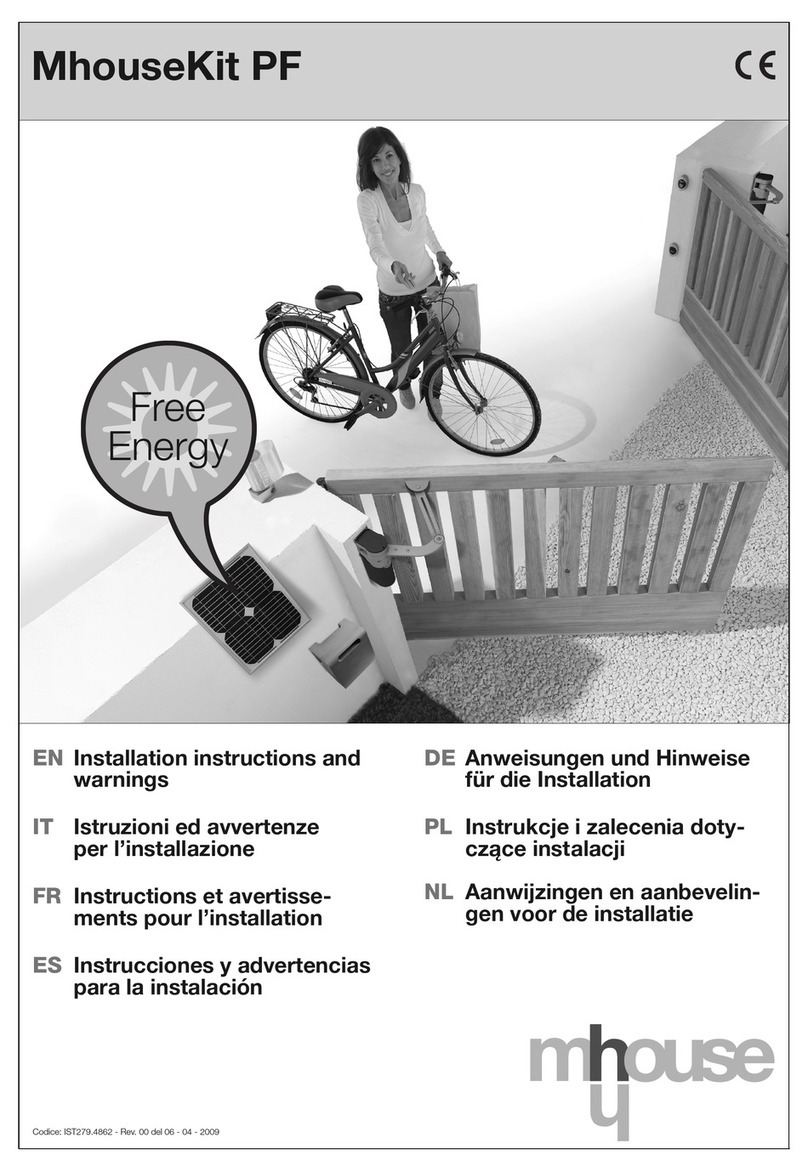
Mhouse
Mhouse MhouseKit PF Product manual
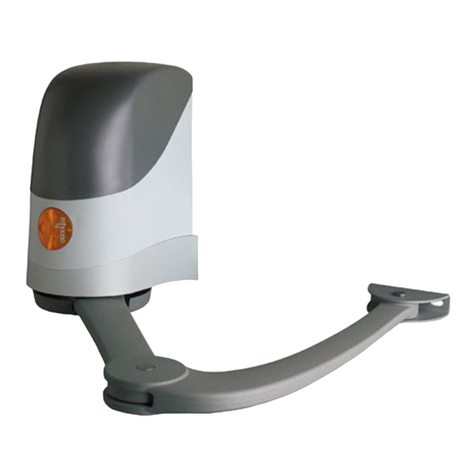
Mhouse
Mhouse MhouseKit WS2S User manual
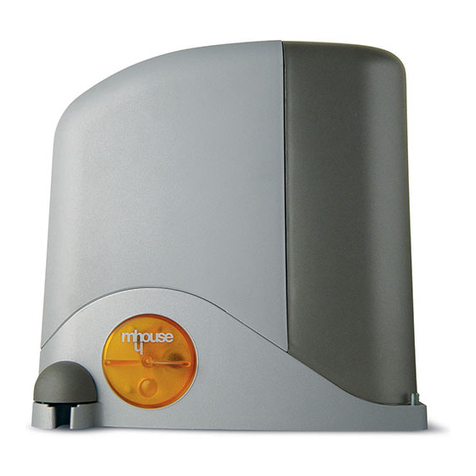
Mhouse
Mhouse SL1S User manual

Mhouse
Mhouse WG2 Product manual
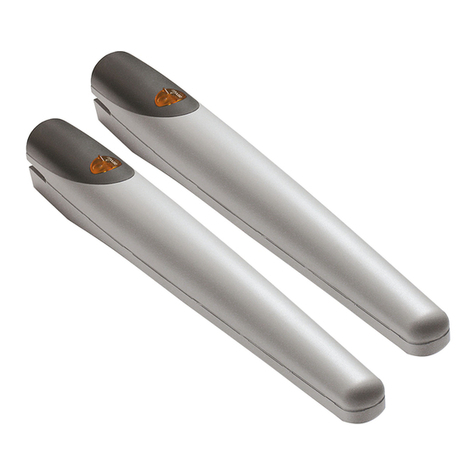
Mhouse
Mhouse WG2 Manual
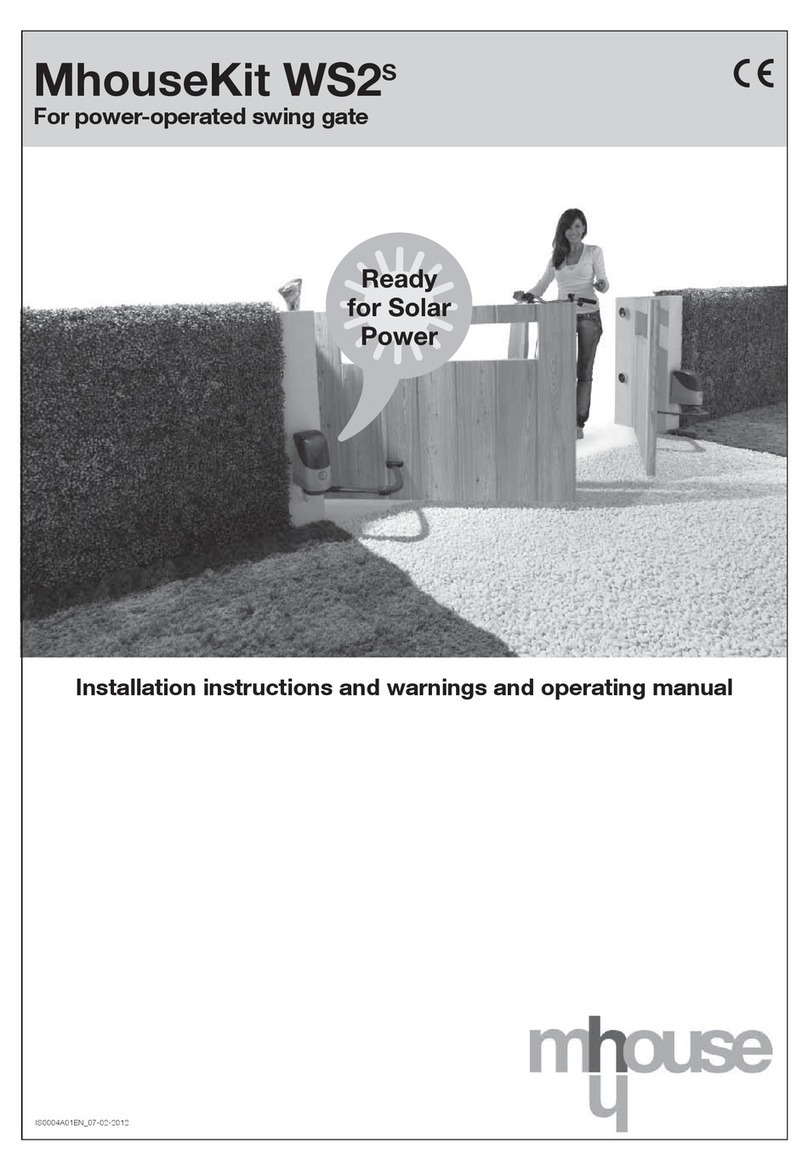
Mhouse
Mhouse MhouseKit WS2S User manual
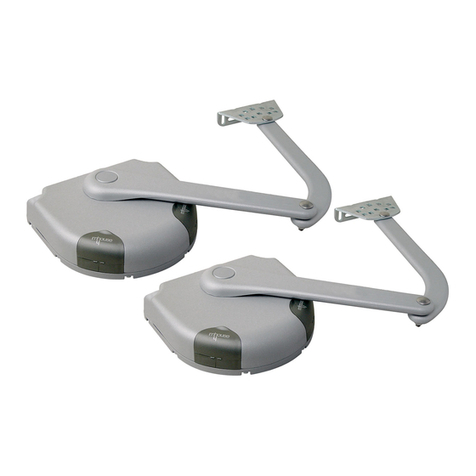
Mhouse
Mhouse MhouseKit WK2 User manual

Mhouse
Mhouse MhouseKit WG2S User manual
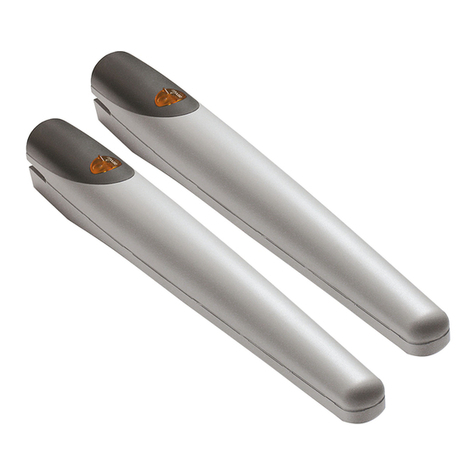
Mhouse
Mhouse WG10SK Product manual

Mhouse
Mhouse WT1S Product manual
Popular Gate Opener manuals by other brands
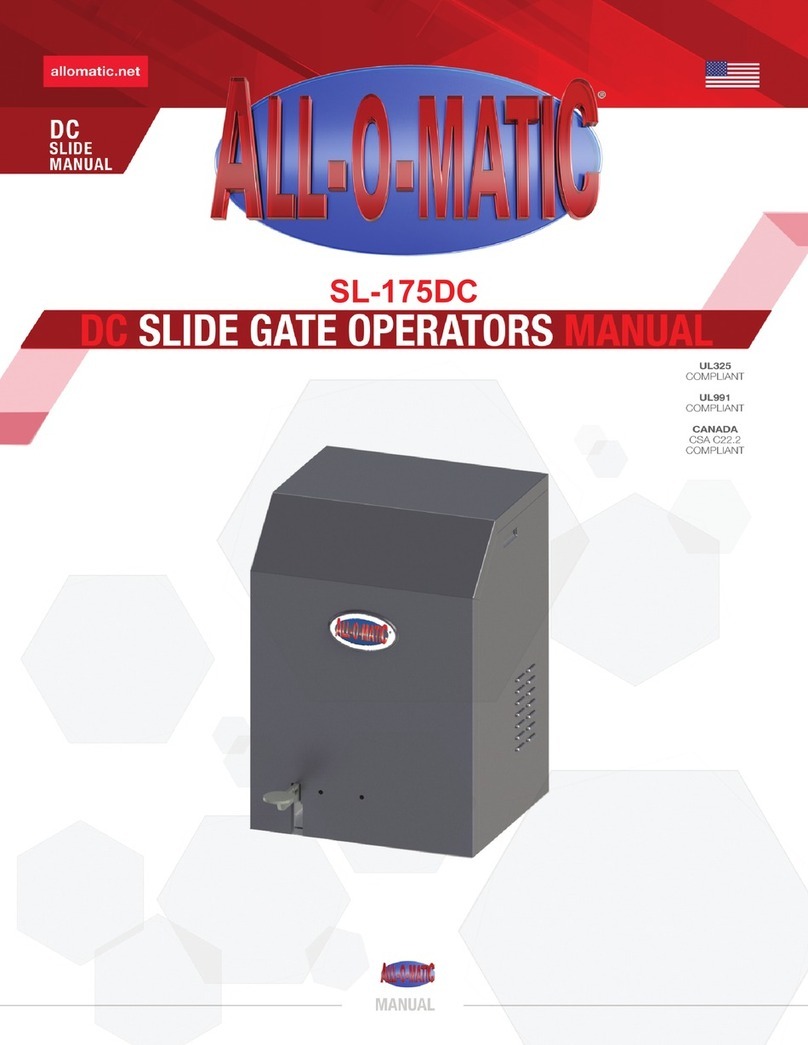
ALLOMATIC
ALLOMATIC SL-175DC manual

BFT
BFT P7 quick start guide
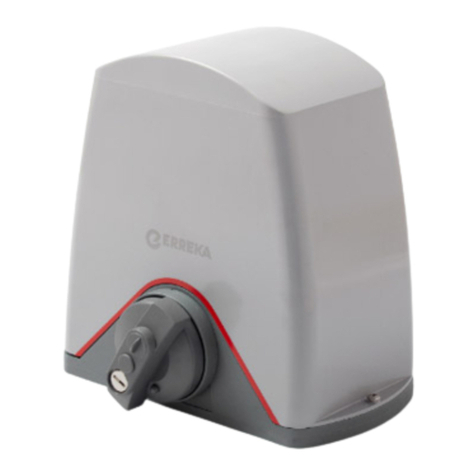
Erreka
Erreka PUMA-I Quick installation and programming guide
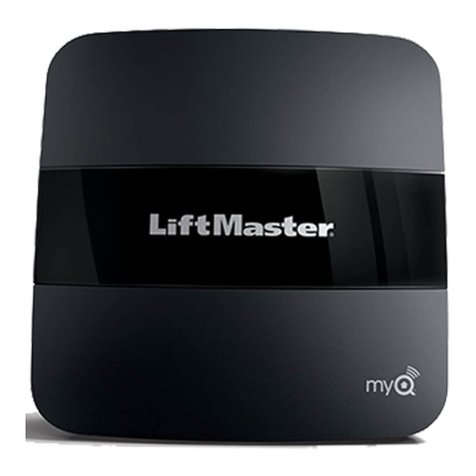
Chamberlain
Chamberlain myQ Home Bridge quick start guide
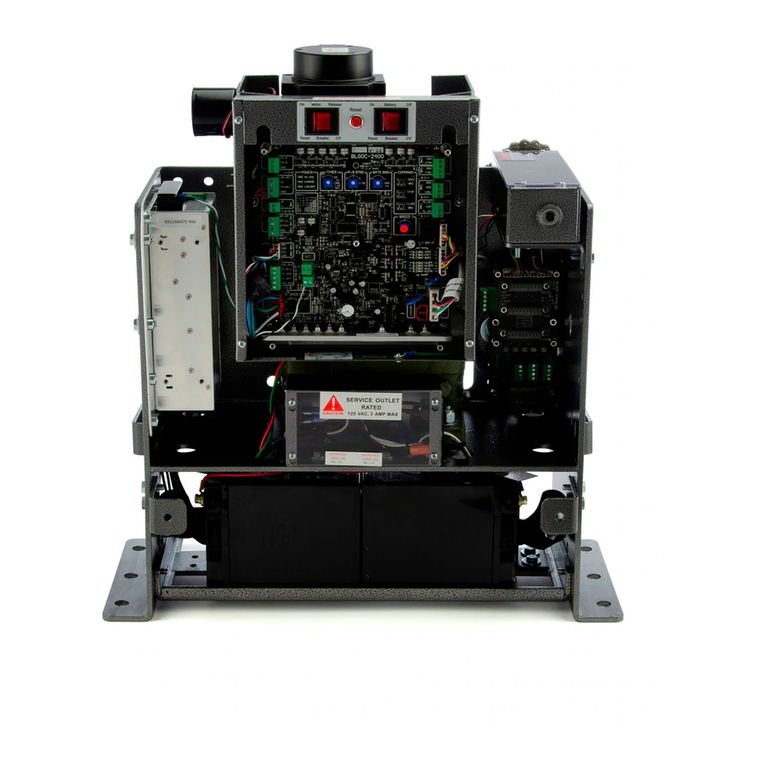
Platinum Access Systems
Platinum Access Systems BLSL3060 Installation instructions & owner's manual
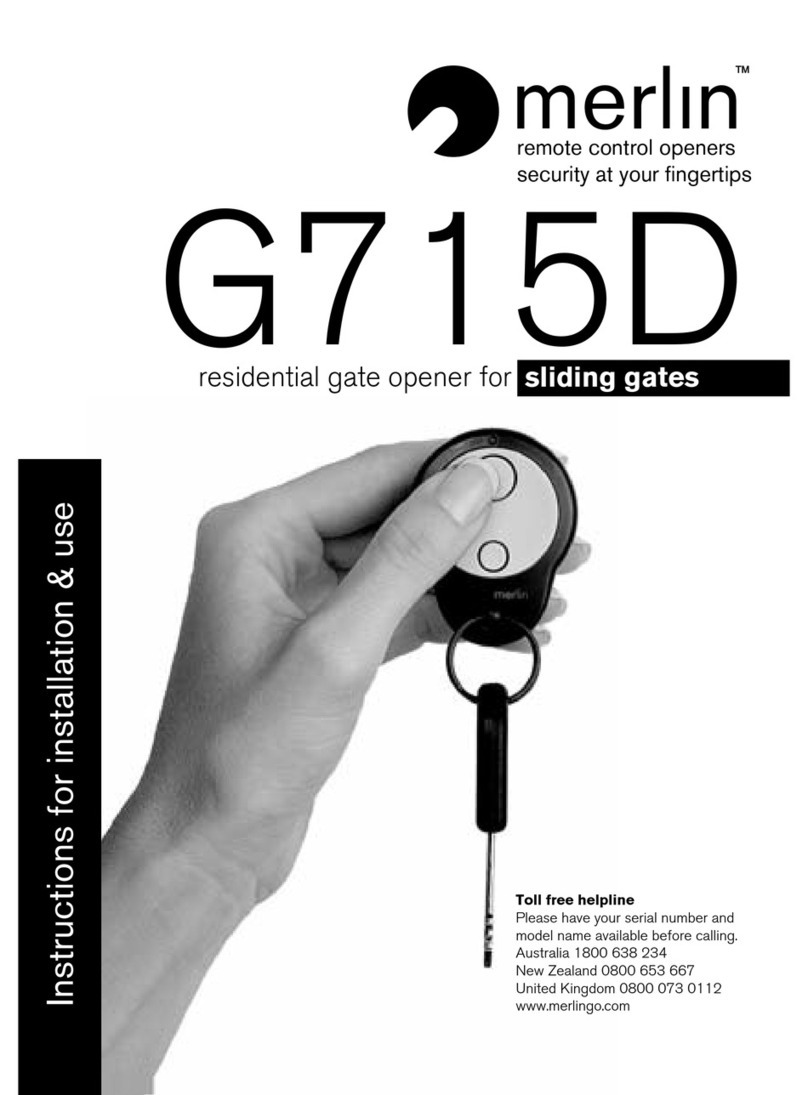
Merlin
Merlin G715D Instructions for installation and use
